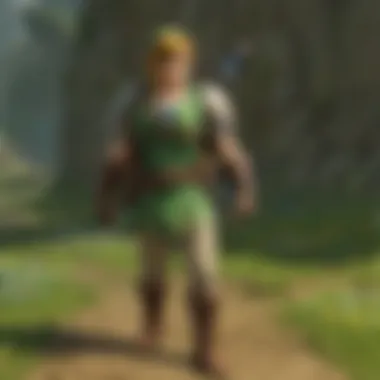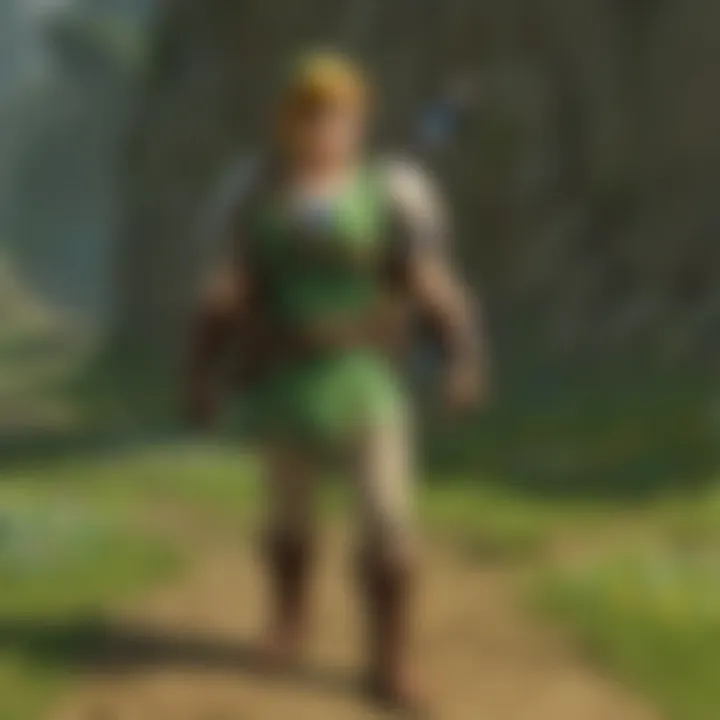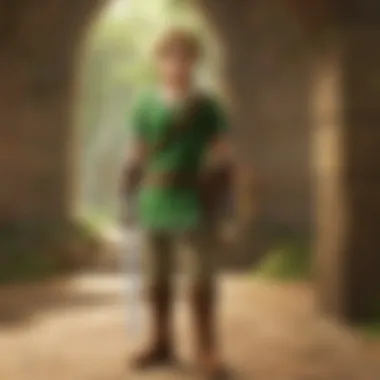Exploring The Legend of Zelda: Ocarina of Time on Switch


Intro
The Legend of Zelda: Ocarina of Time remains a major title within the Zelda franchise. Its adaptation to the Nintendo Switch has reignited interest among both new players and seasoned fans. This shift offers an opportunity to explore how gameplay mechanics, visuals, and overall experience have evolved. Key to understanding the significance of this remix is examining its legacy and cultural impact.
In Ocarina of Time, players embark on a quest with Link as he battles to save Hyrule. The game originally released in 1998 revolutionized open-world gameplay, setting a standard for future titles. The Switch adaptation not only brings superior graphics but also introduces gameplay improvements that align with contemporary gaming expectations.
This article will delve into various aspects of Ocarina of Time on Switch. We will analyze gameplay features and mechanics, storyline, character arcs, and visual enhancements. Discussions will also include its lasting legacy within the franchise and what it means for the future of Zelda.
Game Reviews
Gameplay Features and Mechanics
The gameplay mechanics in Ocarina of Time helped shape the action-adventure genre. Controlling Link involves both combat encounters and puzzle-solving elements. The Switch version maintains the spirit of the original while optimizing controls and responsiveness. Players can expect improved motion controls that enhance swordplay and archery.
Key features include:
- Z-targeting: This mechanic allows players to lock on to enemies, improving combat fluidity.
- Items Management: A streamlined inventory system makes it easier to access items on the Switch.
- Time Travel: The innovative time travel mechanic continues to have significant implications on gameplay, affecting puzzle solutions and interactions.
Storyline and Quests
At the heart of Ocarina of Time lies a rich narrative filled with quests and subplots. The story unfolds as Link evolves from a child to a hero, facing challenges that shape his character. The central quest involves collecting the three Spiritual Stones and later, the seven Sages. Players become invested in the adventure through immersive storytelling and character interactions.
Visuals and Sound Design
Graphically, the Switch version showcases enhanced textures and lighting effects that breathe new life into Hyrule. The nostalgic design is preserved while benefiting from modern technology. Character models are sharper, and environments feel more dynamic.
Sound design, including the iconic music by Koji Kondo, plays a pivotal role in setting the atmosphere. Updated sound quality improves immersion as players experience familiar tunes with richer audio fidelity.
Comparison with Previous Titles
Ocarina of Time stands alongside its sequels, such as Majora's Mask and Breath of the Wild, both of which further pushed boundaries within the franchise. Unlike Majora's Mask's darker themes and time constraints, Ocarina embraces a more classic hero's journey. The adaptation on Switch emphasizes the game’s original charm while integrating modern conveniences that are expected in updated titles.
"Ocarina of Time is not just a game; it's a monumental flag bearer for future adventures in this storied universe."
Character Analyses
In examining the characters, Link's journey remains the focal point. However, characters such as Princess Zelda and Ganondorf are crucial to the plot development. Analyzing their motivations and arcs provides insight into how they contribute to the overall storyline.
Lore Discussions
The lore of Ocarina of Time encapsulates a rich backstory. Examining mythical elements and legendary items gives depth to the world. There's a connection to real-world mythologies, inviting players to ponder larger themes of heroism and destiny.
Gameplay Strategies
To navigate the challenges posed in Ocarina of Time, experts recommend specific strategies for combat techniques, puzzle solutions, and interaction with NPCs. A thorough understanding of the items and their uses in combat can significantly enhance gameplay. Boss battles, while daunting, can be approached with clear tactics, ensuring success.
The examination of these elements unveils not only the adaptation's improvements but also its deep-rooted significance within the Zelda legacy. Players continue to cherish Ocarina of Time, now with fresh perspectives thanks to its availability on the Nintendo Switch.
Preface to The Legend of Zelda: Ocarina of Time
Understanding the significance of The Legend of Zelda: Ocarina of Time is essential when evaluating its adaptation on the Nintendo Switch. This game, initially released in 1998 for the Nintendo 64, marked a major turning point in the action-adventure genre. Its introduction of innovative gameplay mechanics and deep storytelling set a new standard that influences games even today. The Switch version brings this classic to a new audience while presenting longtime fans with enhancements that respect the original vision.
The importance of this title lies not only in its gameplay but also in the emotional investment it demands from players. It establishes a bond between the player and the characters, particularly Link and Princess Zelda. As we delve deeper into the historical context and franchise overview, we uncover how Ocarina of Time has captured the hearts of millions and continues to resonate within the gaming community.
Historical Context
Upon its release, Ocarina of Time was revolutionary. The late 1990s marked a pivotal time in gaming, as developers explored new technologies and interactive narratives. The move to 3D graphics for Ocarina of Time provided a fresh perspective in storytelling, allowing players to immerse themselves in the world of Hyrule like never before. Such advancements were accompanied by an ornate soundtrack and intricate level designs. The game became an instant classic, receiving accolades such as multiple "Game of the Year" titles.
The cultural impact of this game can still be felt today. Its influence extends beyond gameplay mechanics, affecting how narratives are crafted in games. Many sequels and titles in various franchises have drawn from its design choices. The historical relevance of Ocarina of Time is undeniable.
Franchise Overview
The Legend of Zelda franchise began in 1986, created by Shigeru Miyamoto and Takashi Tezuka. It has evolved significantly over the years, and Ocarina of Time is often cited as a high-water mark, defining what players expect from action-adventure games. The blend of exploration, puzzle-solving, and real-time combat birthed a following that remains strong today. New titles continue to honor the legacy of its predecessors while pushing boundaries.


The Switch's adaptation of this classic aims to connect the nostalgic feelings of long-time fans with the excitement of new players. By discussing key elements such as gameplay enhancements and interface updates, we can better appreciate how Ocarina of Time fits into the broader context of the Zelda series. This analysis encourages us to consider not only what makes this game great but also how its legacy informs future developments in the franchise.
Transition to Nintendo Switch
The transition of The Legend of Zelda: Ocarina of Time to the Nintendo Switch represents a significant evolution in how audiences engage with this classic title. This new platform not only breathes fresh life into the game but also serves to illustrate the enduring appeal and impact of the franchise. It allows both new players and nostalgic fans to experience Hyrule through enhanced technical capabilities. Writing about this transition is essential as it highlights the thoughtful considerations involved in bridging the original masterpiece with modern technology.
Technical Enhancements
The technical enhancements brought forth in the Switch version of Ocarina of Time are notable. One key aspect is the improved graphics. The game runs at a higher resolution, offering clearer visuals that enhance the game's colorful environments. The vibrant landscapes of Hyrule, iconic characters, and intricate designs of various locations benefit from this uplift. Moreover, the frame rate has been optimized, providing smoother gameplay that reduces lag and enhances action sequences.
Another component of the technical advancements is the loading times. The Switch’s architecture allows for faster performance, which means players can dive into the action more quickly. This efficiency is particularly appreciated when navigating between locations in the expansive world, which was sometimes marred by lengthy load times in earlier versions.
Additionally, support for the Nintendo Switch's gyroscopic controls provides a novel way to interact with the game. This implementation can be utilized in certain gameplay mechanics such as aiming projectiles or solving puzzles, making the experience more immersive and interactive than ever before.
User Interface Updates
User interface updates in the Switch version further enhance the overall gaming experience. The controls have been tailored for the Joy-Con controllers, providing responsive and intuitive inputs. The layout of the buttons has been optimized to ensure that accessing items, using weapons, and navigating menus feels seamless.
One significant improvement is the integration of a more streamlined inventory system. Players can expect easier access to their items and equipment, minimizing frustration during gameplay. This is particularly vital in critical moments when quick decision-making is essential, such as during combat or exploration.
Additionally, the HUD (Heads-Up Display) has received a makeover. Information is presented more clearly, making it simpler for players to track their progress, health, and other essential statistics. The thoughtful arrangement ensures that gameplay remains fluid without cluttering the screen, allowing players to focus on the story and adventure.
"The blend of nostalgia and modern gameplay mechanics in Ocarina of Time on Switch creates a unique experience that is both familiar and groundbreaking."
In sum, the transition to the Nintendo Switch signifies a blend of technological improvement and user-centered design. It positions Ocarina of Time in a way that resonates with both long-time fans and newcomers alike, enhancing its legacy for future generations to discover.
Gameplay Mechanics
Gameplay mechanics play a crucial role in defining the experience of any video game, especially for a title as revered as Ocarina of Time. On the Nintendo Switch, the mechanics guiding player interactions enhance not only the enjoyment but also the depth of engagement with the game. Players encounter directions, combat opportunities, puzzles, and exploration that must intertwine seamlessly to create an immersive experience. Each mechanic brings its dimension, requiring players to adapt and strategize. This adaptability is what makes the game intriguing.
Combat System Evolution
In Ocarina of Time, the combat system has undergone notable evolution. Originally, the game introduced a targeting system known as Z-targeting, facilitating precise attacks and defensive maneuvers. This feature made battles more strategic than mere button-mashing. On the Switch, these mechanics remain intact but have been fine-tuned to provide smoother controls and better response times. Players can now experience combat sequences that are faster and more fluid, which is essential when engaging with formidable foes like Ganondorf.
The inclusion of new contextual commands allows Link to perform actions that were cumbersome in the past versions, such as dodging or executing special moves. The added clarity and fluidity of the combat system on Switch give players a sense of empowerment. Enemies exhibit more intelligent behaviors, necessitating a thoughtful approach to each encounter. This deepens the tactical component of battles while also elevating the overall excitement for the player.
Puzzle Solving Mechanics
Puzzle-solving is a cornerstone of Ocarina of Time, demanding both critical thinking and creativity from players. Various puzzles challenge players through clever designs; whether it’s moving blocks, deciphering riddles, or manipulating the environment, these mechanics encourage exploration and experimentation. The Switch adaptation ensures these puzzles maintain their original charm while also benefitting from refinements in user interface and graphics.
Players find themselves using the Ocarina in new ways that enhance puzzle engagement. The responsive controls make it simpler to interact with multiple elements at once, allowing for more complex problem-solving scenarios. Feedback from each interaction is clearer, which reduces frustration while encouraging experimentation. The textured graphics allow for greater visual clues, helping the player connect the dots in a more intuitive manner. This evolution enhances the enjoyment derived from puzzle-solving.
Exploration Dynamics
Exploration is integral to Ocarina of Time, inviting players to lose themselves in the expansive world of Hyrule. Navigating the landscapes, discovering hidden secrets, and interacting with NPCs provide a sense of freedom. The Switch version amplifies this exploration through improved graphics and performance, presenting a vibrant world filled with detail. Players are drawn to explore every nook and cranny as they seek power-ups, collectibles, and lore.
The mechanics governing exploration are user-friendly yet encourage discovery. With the map integration and user interface updates, finding areas of interest becomes a more fluid experience. The game’s level design is crafted to reward curiosity; hidden treasures or narrative elements can be uncovered just by wandering off the beaten path. This evolution in exploration mechanics fosters a satisfying sense of accomplishment and encourages players to engage deeply with the world.
"In the world of Ocarina of Time, exploration feels rewarding and immersive, making every venture a potential adventure."
In summary, the gameplay mechanics of Ocarina of Time on the Switch emphasize enhanced combat, intricate puzzle dynamics, and rewarding exploration. These elements blend seamlessly to create an environment that respects the original while also pushing the boundaries of how players interact with the game.
Visual and Audio Enhancements
The aspects of visual and audio enhancements in the Nintendo Switch rendition of Ocarina of Time contribute significantly to the overall gaming experience. These enhancements not only modernize the visuals and sound but also deepen the player’s immersion into the world of Hyrule. A well-crafted audio-visual experience plays a role in reinforcing the emotional resonance of the storyline as well as in creating a connection between the player and the characters.
Graphical Improvements
The graphical improvements in Ocarina of Time on the Switch enhance the game’s visual storytelling. The original game had limitations due to hardware constraints of its time. However, the Switch version effectively leverages modern rendering techniques to deliver a cleaner, sharper image. Textures are more detailed, and the character models appear smoother and more defined. This refinement is particularly noticeable in the game's environments, where lush landscapes and intricate dungeons now fully emerge with vibrant colors and subtle lighting effects.
Additionally, aspects like anti-aliasing help in reducing jagged edges, making the game visually appealing. The improved aesthetic can draw new players while also engaging long-time fans who can appreciate the care taken in updating this classic title.
- Enhanced texture resolution
- Smoother character models
- Improved lighting and shading effects
These graphical adjustments serve not just as a superficial upgrade. They allow players to explore and fully appreciate the rich details of Hyrule, encouraging longer gaming sessions and deepening the investment in gameplay.


Soundtrack and Audio Quality
The audio components of Ocarina of Time on Switch also saw considerable improvement. The soundtrack remains one of the most celebrated elements of the franchise. The enhanced audio quality ensures that players experience the music as intended, with richer soundscapes and clearer instrumentation. The iconic melodies, whether it is the serene tones of the Kokiri Forest or the ominous theme when facing Ganon, now resonate more effectively.
Improved audio fidelity makes it easier to absorb the subtle nuances in music, allowing gamers to appreciate how sound design complements gameplay. Moreover, ambient sounds present a more immersive experience. Players can now hear the gentle rustle of leaves or the distant calls of creatures, adding to the world’s liveliness.
"The sounds are the heartbeat of the adventure, guiding the player through each memorable moment." - An avid Zelda fan
The combination of revamped visuals and audio creates an atmosphere that draws players into the world of Ocarina of Time in a more profound way than the original release. As a whole, these elements contribute to a heightening of emotional stakes within the narrative, making the Switch version a noteworthy experience for both newcomers and returning players.
Character Analysis
In the world of The Legend of Zelda: Ocarina of Time, characters serve not just as players' avatars or enemies, but as pivotal components that shape the narrative. Understanding these characters provides deeper insight into the game's themes and dynamics. Analyzing character development and roles can enhance the experience of both new players and longtime fans. Each character embodies different aspects of the story, making it essential to examine their motivations and arcs, and how they connect to the player's journey.
Link: The Hero's Journey
Link is the protagonist and representation of the classic hero's journey in this game. He begins as a young boy in the Kokiri Forest, somewhat naive and unaware of his destiny. As players guide him, they witness his evolution into a skilled warrior. This growth is not just physical but also emotional. Throughout the game, Link faces various challenges that test his courage and wisdom.
Such challenges include battling monsters and solving complex puzzles, which signify both his physical and moral growth. Link's reliance on tools like the Ocarina and Master Sword illustrates how he learns to wield power responsibly. His mission is to rescue Princess Zelda and defeat Ganondorf, emphasizing themes of bravery, goodwill, and sacrifice. "When you finally defeat Ganondorf, Link represents the hope that everyone has put in him."
Zelda: Role and Development
Princess Zelda is a key figure in Ocarina of Time, embodying characteristics beyond that of a traditional damsel in distress. Initially, she appears as Princess Zelda, but her true identity as Sheik reveals her complexity. As Sheik, she aids Link several times, showcasing her courage and intelligence. Zelda’s ability to adopt different forms highlights her adaptability in dire circumstances.
Her development throughout the narrative feeds into larger themes of destiny and choice. The bond between Link and Zelda emphasizes the importance of partnership and trust. She is not merely a goal for Link but is integral to the storyline and serves as a catalyst for the hero's quest. This complex character evolution captures attention and reflects the intricate world surrounding Ocarina of Time.
Villains of Ocarina of Time
The villains in Ocarina of Time, particularly Ganondorf, provide critical opposition that drives the plot forward. Ganondorf is crafted as a menacing and powerful figure representing evil and corruption. His motives—seeking power and domination—contrast sharply with Link and Zelda’s quest for peace. This contrast is essential as it underscores the struggle between good and evil and keeps players invested in the outcome.
Moreover, lesser antagonists, like the various bosses Link encounters, enrich this conflict. Each villain brings unique challenges, requiring players to adapt their strategies. The diversity of enemies illustrates the multilayered nature of conflicts in the game. It shows that evil takes many forms, and confronting such evils compels growth. Players, therefore, not only combat external threats but must also grapple with moral questions about power and responsibility.
To summarize, character analysis in The Legend of Zelda: Ocarina of Time provides a rich understanding of the story. Link and Zelda represent ideals of heroism and partnership, while Ganondorf and others signify the obstacles to be overcome. An appreciation of these characters and their arcs enhances the ability to engage with the game's deeper meanings.
Lore and Narrative Structure
The lore and narrative structure of The Legend of Zelda: Ocarina of Time play a crucial role in understanding its enduring appeal. The intricate plot, rich character backstories, and the themes woven throughout create a captivating world that resonates with players across generations. This section examines how these elements contribute to the immersive experience of the game on the Nintendo Switch, enhancing both gameplay and storytelling.
Plot Synopsis
Ocarina of Time presents a compelling journey with Link, a young boy destined to become a hero. The game begins in the peaceful Kokiri Forest, where Link, raised by the Great Deku Tree, is suddenly thrust into an epic struggle against the dark forces led by Ganondorf. The narrative unfolds as Link travels between two distinct timelines, shaped by his ability to manipulate time through the ocarina.
The primary plot revolves around Link's quest to gather the three Spiritual Stones and access the sacred realm, where the Master Sword lies. His goal is to thwart Ganondorf’s plans to retrieve the Triforce and plunge Hyrule into darkness. The narrative takes a darker turn when Link is sealed away for seven years and returns as an adult. He must now confront Ganondorf and unite the seven Sages to restore peace to Hyrule. The conclusion culminates in a dramatic clash between light and darkness, emphasizing Link's growth and resilience.
Themes and Motifs
The themes in Ocarina of Time are as rich as its narrative. Some significant themes include:
- Courage and Growth: Link’s evolution from a naive child to a courageous hero illustrates the theme of personal growth through trials.
- Time and Memory: The ability to travel through time plays a pivotal role, symbolizing the importance of learning from the past while forging one's future.
- Friendship and Loyalty: Relationships with characters such as Zelda and Navi highlight the importance of companionship and the commitment to protecting loved ones.
- Good vs. Evil: The classic struggle between Link and Ganondorf serves as a reminder of the ongoing battle between light and darkness.
These themes not only elevate the story's depth but also forge a connection with players.
"A great game is not only about mechanics but also about the stories that it tells. Ocarina of Time achieved both through its narrative depth."
Comparison with Original Release
The comparison of The Legend of Zelda: Ocarina of Time on the Nintendo Switch with its original release is essential for understanding how the gaming experience has evolved. As a landmark title in the franchise, its reinvention for modern consoles shows both respect for its roots and a willingness to innovate for new audiences. This section explores gameplay adjustments, technological advances, and community reception to paint a comprehensive picture of the game's legacy.
Gameplay Adjustments
In transitioning to the Nintendo Switch, several gameplay adjustments were made to enhance the overall player experience. One significant change is the refined control scheme. The original game relied heavily on the Nintendo 64 controller layout, which may feel dated to many. The Switch allows for greater flexibility with its Joy-Con controllers. Players now have customizable controls, which can improve accessibility and comfort.
Moreover, the pacing of gameplay has seen improvements. Aspects such as fast travel mechanics were integrated to reduce tedious backtracking. This adjustment keeps players engaged, allowing them to enjoy the adventure without unnecessary interruptions.
Another notable alteration is the integration of save states, which supports both casual and hardcore gamers. This feature permits players to save their progress at virtually any point, which is a departure from the original game’s more rigid saving structure. Now, a new generation of players can explore the vast world of Hyrule without the fear of losing hours of progress.
Technological Advances
The remastered edition on Switch includes significant technological advances that boost the gameplay experience. The visual fidelity has markedly improved with higher resolution textures and enhanced frame rates. This graphical update not only breathes new life into the game but also makes the environments more engaging and immersive.
Furthermore, the audio enhancements contribute to a more vibrant experience. The original soundtrack, hailed for its quality, now benefits from improved sound sampling technology. The clarity of the music and sound effects makes a considerable difference in how players connect with the game.
"The Legend of Zelda: Ocarina of Time has always been about immersion. The Switch remaster amplifies this with technological benefits that modern players expect."
Another crucial technological aspect is the incorporation of HD Rumble, which adds a layer of tactile feedback during gameplay. This feature helps deepen the player's immersion into the game, providing more responsive interactions with the title's various mechanics.
Community Reception
Community reception to the Switch version of Ocarina of Time has been largely positive. Fans of the franchise have welcomed the opportunity to experience a beloved classic with modern enhancements. Social media platforms and forums, such as Reddit, have hosted vibrant discussions examining both nostalgia and the improved mechanics.
Many players express appreciation for the balance between preserving the original's charm while making necessary updates. The new gameplay features and improvements have led to a renewed interest from both old fans and newcomers.
In addition, the remake's availability on a portable console has sparked excitement. Players can traverse the vast lands of Hyrule at their leisure on the go, which aligns perfectly with the Switch's flexibility.
However, some veteran players have expressed concern about changes that may deviate from their original experiences. There is always a segment of long-time fans who appreciate the challenges the original game presented. Overall, the overall reception has been a tapestry of nostalgia interwoven with excitement for the future of the franchise.
Cultural Significance of Ocarina of Time
The cultural significance of The Legend of Zelda: Ocarina of Time extends far beyond its gameplay and graphics. It played a pivotal role in shaping the perception of video games as a serious form of art and entertainment. Released originally in 1998, it introduced many mechanics and narrative structures that have since become fundamental to the action-adventure genre. This section discusses how this title influenced future games and solidified its legacy in gaming history.
Influence on Future Titles
Ocarina of Time set a benchmark for game design that many developers aspired to reach. Its open-world structure allowed players to explore the vast landscape of Hyrule, creating a sense of freedom that few games had offered before. The introduction of Z-targeting revolutionized combat mechanics, enabling more fluid and engaging gameplay. A few key influences on future titles include:
- Open world exploration: Games like Breath of the Wild draw directly from the expansive environments that Ocarina pioneered.
- Complex narratives: The focus on story depth in games like The Witcher 3 and the Dark Souls series can be traced back to Ocarina's narrative structures.
- Character development: Titles such as Last of Us and The Legend of Zelda: Majora's Mask exemplify how character arcs can enhance player engagement, in ways seen first in Ocarina.
These elements show that Ocarina of Time was not just a game, but a standard setter whose impact resonates through numerous successful franchises.
Legacy in Gaming History
The legacy of Ocarina of Time is cemented within the annals of gaming history. It has frequently appeared in discussions surrounding the greatest games ever made. Its accolades are numerous, including:
- Critical acclaim: The game received near-perfect scores from various gaming publications upon its release. It continues to rank high on lists of top games.
- Innovation: Ocarina was among the first to fuse 3D animation with a rich storyline, leading the way for future innovations in 3D gaming.
- Cultural references: The game has become a part of popular culture, referenced in various media and inspiring a dedicated fanbase.
Overall, Ocarina of Time not only defined the Zelda franchise but also significantly influenced the broader gaming landscape. Its combination of gameplay, storytelling, and innovative mechanics redefined what video games could achieve and set new expectations for future titles.
Future Prospects for Zelda on Switch
The future of The Legend of Zelda franchise on the Nintendo Switch represents both an exciting pathway and a critical juncture for fans and developers alike. With Ocarina of Time being a seminal title in gaming history, its new adaptation raises questions on how future games may innovate while respecting the rich legacy established decades ago. This section aims to synthesize important elements, benefits, and considerations regarding the trajectory of the franchise on the Switch platform, which is central to this article.
Speculations on Franchise Direction
As we look ahead, the direction of the Zelda franchise on the Switch hinges on several factors, including technological advancements, player expectations, and storytelling potential. There is an ongoing discussion among enthusiasts about the possible return to classic gameplay elements fused with modern mechanics. Many speculate that future titles might embrace a hybrid approach, integrating the open-world exploration seen in Breath of the Wild with the more structured storytelling of earlier titles, like Ocarina of Time.
Furthermore, enhanced hardware capabilities of the Switch suggest that future releases could offer even more intricate graphics, improved AI behavior, and additional layers of interactivity. This could revolutionize the player's experience, making it more immersive. Additionally, the change in audience demographics—more gamers being introduced to the franchise—will likely shape game design to be both accessible to new players and rewarding to long-time fans.
This creates an interesting tension where the franchise must evolve while still honoring its roots. As discussed in various online forums, including Reddit, many fans express their hopes for the franchise to explore new narratives, perhaps delving deeper into the history of Hyrule or the Triforce itself, creating paths for storytelling that were not previously explored.
Potential Game Developments
Envisioning what Zelda on Switch will look like involves contemplating various aspects of game development.
- New Gameplay Mechanics: Future installments might experiment with innovative gameplay systems, such as reimagined combat strategies or deeper crafting systems that engage players in ways previous titles have not.
- Expansive Worlds: Fans could expect larger, more detailed worlds akin to what was delivered in Breath of the Wild, but perhaps with additional hubs or cities that feel distinct and engaging.
- Multiplayer Elements: The introduction of cooperative gameplay could also be on the horizon, promoting interaction between players without sacrificing the traditional single-player experience.
- Diverse Character Arcs: Opportunities for richer character development and multiple perspectives have never been more pronounced. New gameplay could allow switching between characters, providing unique abilities and storylines, enhancing the narrative.
- Regular Content Updates: Given the ongoing popularity of live-service games, there is potential for episodic content and expansions that keep players engaged long after the initial release.
End
In evaluating the significance of The Legend of Zelda: Ocarina of Time on the Nintendo Switch, it becomes clear that this timeless classic’s reinvention reinforces its status in gaming culture. The article has delved into various aspects, including technical enhancements, gameplay mechanics, and its broader cultural implications, revealing how the adaptation has influenced both the game itself and its audience.
Summary of Findings
The Switch version of Ocarina of Time brings forth numerous improvements. First, the technical enhancements improve the game's graphics and performance, as the Switch hardware allows for smoother play and clearer visuals. Next, the game maintains the core mechanics, such as its combat and puzzle-solving elements, while offering modern refinements that facilitate a more engaging experience. Furthermore, character arcs have been strengthened, providing players with deeper connections to Link, Zelda, and the various villains encountered throughout the narrative.
The legacy of Ocarina of Time is also thoroughly examined. The game not only set standards for 3D action-adventure titles but also influenced many successors within the Zelda franchise. Its music, lore, and distinctive gameplay continue to resonate, ensuring its relevance in today’s gaming landscape.
Final Thoughts on Ocarina of Time
Ultimately, the transition of Ocarina of Time to the Switch represents more than just a revival of a classic. It highlights the adaptability of the franchise and the importance of retaining its essence while innovating for new hardware. For long-time fans and newcomers alike, this adaptation offers an opportunity to rediscover a cherished title through an updated lens.







